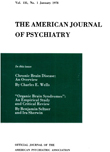THE RESPONSE OF SEVERELY ILL CHRONIC SCHIZOPHRENIC PATIENTS TO SOCIAL STIMULATION
Abstract
Twenty-two long-stay severely ill male schizophrenic patients were employed in a hospital workshop for 16 weeks. They all lived in one villa where the standard of social treatment was high. The two workshop supervisors were a male and a female staff nurse. The sex of the supervisor did not influence the results. The conditions of supervision were varied experimentally. There was a sharp increase in output (on a simple sleeve folding task) whenever social incentives were introduced, and a sharp fall whenever passive conditions of supervision were resumed. The 10 patients with the highest initial output, together with 1 other (ranked 13 on initial output), accounted for over 90% of the output under passive conditions, and for all the improvement due to practice. However, they contributed only 40% of the improvement due to additional social incentives. The remaining patients, therefore, functioned at a very low level relative to the initially high scorers and showed no practice effect, but 7 of them responded very markedly to encouragement. Time-sampling of workshop behaviour showed that the increase in working activity, under active conditions of supervision, was accompanied by a significant decrease in various abnormalities of behaviour (immobility, mannerisms and restlessness). Ward behaviour was unaffected.
Access content
To read the fulltext, please use one of the options below to sign in or purchase access.- Personal login
- Institutional Login
- Sign in via OpenAthens
- Register for access
-
Please login/register if you wish to pair your device and check access availability.
Not a subscriber?
PsychiatryOnline subscription options offer access to the DSM-5 library, books, journals, CME, and patient resources. This all-in-one virtual library provides psychiatrists and mental health professionals with key resources for diagnosis, treatment, research, and professional development.
Need more help? PsychiatryOnline Customer Service may be reached by emailing [email protected] or by calling 800-368-5777 (in the U.S.) or 703-907-7322 (outside the U.S.).



